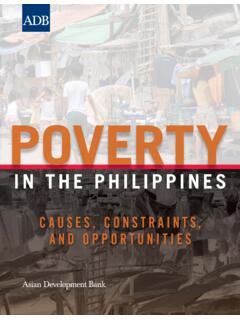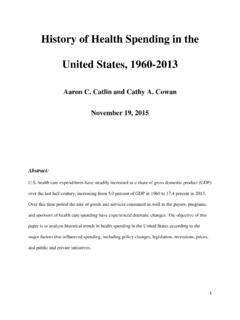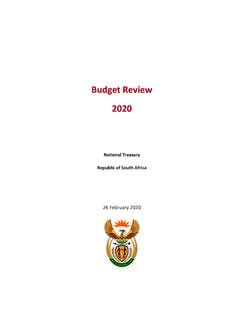Transcription of INVESTING IN HEALTH FOR ECONOMIC DEVELOPMENT
1 1 The Demographic NexusVersion for Consultation and CommentsINVESTING IN HEALTH FOR ECONOMIC DEVELOPMENTE xecutive Summary2 INVESTING IN HEALTH FOR ECONOMIC DEVELOPMENTR eport by the Mexican Commission on Macroeconomics and health3 The Demographic NexusFirst edition 2004 Universidad de las Am ricas, PueblaSanta Catarina M rtir, Cholula, 72820 Puebla, M xicoCopyrigth 2004 Printed in MexicoISBN 968-6254-66-82 INVESTING IN HEALTH FOR ECONOMIC DEVELOPMENTR eport by the Mexican Commission on Macroeconomics and health3 The Demographic NexusNOTE FOR READERSThe Mexican Commission on Macroeconomics and HEALTH was created on July 29th, 2002 by the initiative of the Minister of HEALTH of Mexico, Julio Frenk.
2 The Commission includes experts from academic institutions, the government, civil society and the private sector. Based on their professional experience, these experts have been able to analyze and reflect upon the link between HEALTH and ECONOMIC DEVELOPMENT . The current edition of the Commission s Report, entitled Macroeconomics and HEALTH : INVESTING in HEALTH for ECONOMIC DEVELOPMENT , is meant for dialogue with a broad range of actors, (which will take place between November 2004 and February 2005) with the purpose of creating a consensus in terms of goals, process and outcomes.
3 This Executive Summary presents a synthesis of the Commission s analysis, conclusions and recommendations. Those who wish to make comments via e-mail can send them to order to keep the document short, this Executive Summary does not include the list of background papers or references. They can, however, be found in the complete Report also available at the following web page: It is my sincere hope, that the reader will find this Executive Summary of interest and LustigPresident of the Mexican Commission on Macroeconomics and Health4 INVESTING IN HEALTH FOR ECONOMIC DEVELOPMENTR eport by the Mexican Commission on Macroeconomics and health5 The Demographic NexusCopies of this publication can be requested from.
4 Instituto de Pol ticas P blicas y Estudios del Desarrollo (IPD)Universidad de las Am ricas, PueblaSanta Catarina M rtir, Cholula72820, PueblaTel.: 52 222 229 2000 Ext. 4583, 4578 Fax: 52 222 229 2270e-mail: IN HEALTH FOR ECONOMIC DEVELOPMENTR eport by the Mexican Commission on Macroeconomics and health5 The Demographic NexusTABLE OF CONTENTS PrefaceAcknowledgementsIntroduction I. HEALTH and ECONOMIC GrowthII. HEALTH and Poverty Traps III. What HEALTH Goals Should Be Chosen for Mexico?IV. Are we INVESTING Well in HEALTH ?
5 V. Social Protection for Everyone?VI. Public Goods for HealthVII. Conclusions and Recommendations TABLES AND FIGUREST able 1 Human DEVELOPMENT Index (HDI) for Different Regionsof Mexico in 2002 Table 2 HEALTH System Performance Indicators for a Selection of CountriesTable 3 Inventory of Public Goods in HealthTable 4 Mechanisms for the Creation of Public GoodsFigure 1 Intergenerational Cycle of Human Capital Formation Figure 2 Breakdown of HEALTH expenditure , 2001 Figure 3 Distribution of Social expenditure by Income Decil, 2002 Figure 4 Concentration Coefficients of Public expenditure on Healthand Nutrition.
6 2000-2002 Figure 5 Coverage of Oportunidades and Access to Social Security, Mexicop IN HEALTH FOR ECONOMIC DEVELOPMENTR eport by the Mexican Commission on Macroeconomics and health7 The Demographic Nexus6 INVESTING IN HEALTH FOR ECONOMIC DEVELOPMENTR eport by the Mexican Commission on Macroeconomics and health7 The Demographic NexusPREFACEThe Commission on Macroeconomics and HEALTH (CMH) was created in January 2000 as an initiative launched by the World HEALTH Organization (WHO) and chaired by the economist Jeffrey Sachs.
7 This Commission s Report was published on December 20th, 2001. The CMH s main objective was to identify the importance of improving HEALTH standards and to calculate additional resources as well as necessary actions on a national and international level in order to promote ECONOMIC DEVELOPMENT . Its attention was focused on the countries that are unable to advance on their own and for which international aid is essential. In the case of middle-income countries, the CMH stated the following:In most middle-income countries, average HEALTH spending per person is already adequate to ensure universal coverage for essential interventions.
8 Yet such coverage does not reach many of the poor. Exclusion is often concentrated by region ( , rural western China and rural northeast Brazil), or among ethnic and racial minorities. For whatever reason, public-sector spending on HEALTH does not attend sufficiently to the needs of the poor. Moreover, since many middle-income countries provide inadequate financial protection for large portions of their population, catastrophic medical expenses impoverish many households. In view of the adverse consequences of ill HEALTH on overall ECONOMIC DEVELOPMENT and poverty reduction, we strongly urge the middle-income countries to undertake fiscal and organizational reforms to ensure universal coverage for priority HEALTH We also believe that the World Bank and the regional DEVELOPMENT banks, through nonconcessional financing, can help these countries to make a multi-year transition to universal coverage for essential HEALTH .
9 The CMH suggested the creation of similar commissions on a national level. On the basis of this recommendation, the Minister of HEALTH of Mexico, Dr. Julio Frenk established the Mexican Commission on Macroeconomics and HEALTH 1 Macroeconomics and HEALTH : INVESTING in HEALTH for ECONOMIC DEVELOPMENT , Report of the Commission on Macroeconomics and HEALTH , WHO IN HEALTH FOR ECONOMIC DEVELOPMENTR eport by the Mexican Commission on Macroeconomics and health9 The Demographic Nexus(MCMH) on July 29th, 2002.
10 The thirty-member Commission includes experts from academic institutions, the government, civil society and the private sector. Due to their professional experience, these experts have been able to analyze and reflect upon the link between HEALTH and ECONOMIC DEVELOPMENT . The Commission s mandate consists of 1) analyzing the relationship between INVESTING in HEALTH and the ECONOMIC DEVELOPMENT of Mexico; 2) evaluating the extent to which advances have been made in HEALTH indicators in our country, the characteristics of Mexico s investment in HEALTH (specifically, the level, distribution and the share dedicated to public goods) and the system of social protection against adverse HEALTH shocks.
















